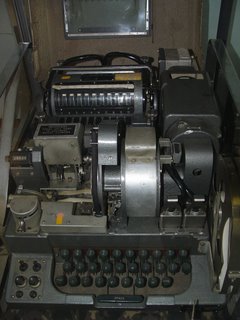British rotor machine: Singlet (BID/60)
 It's fun to see more information on rotor machines entering the public domain. For example, the Swiss NEMA machine was declassified in 1992. More recently, lots of information on the Soviet rotor machine Fialka (M-125) has been published on the Internet. There's even been a loosening of information about the US/NATO KL-7 system.
It's fun to see more information on rotor machines entering the public domain. For example, the Swiss NEMA machine was declassified in 1992. More recently, lots of information on the Soviet rotor machine Fialka (M-125) has been published on the Internet. There's even been a loosening of information about the US/NATO KL-7 system.This year, a British rotor machine named Singlet (BID/60) was put on display at Bletchley Park in the superb Enigma and Friends exhibit put together by David White and John Alexander. There doesn't seem to have been much -- if anything -- written about this machine in the open literature.
The caption at Bletchley Park reads: "Singlet was used mainly by the British intelligence services C. 1949 / 50 onwards. This is a `Cold War' machine using wired rotors to achieve secure messages. We are very grateful to the Foreign and Commonwealth Office and GCHQ for this opportunity to show `Singlet' here at BP."
Singlet has windows and stepping levers for ten rotors. The rotor tube appears to be a detachable section, labelled BID/60/3, while the base unit is labelled BID/60/1. There is a hint of a connection to the KL-7 in this naming. According to George Mace on Jerry Proc's KL-7 page, the KL-7 components were originally labelled as follows: "the base unit was AFSAM 7/1 (aka KLB), rotor stepping unit AFSAM 7/2 (aka
KLA) and rotor basket AFSAM 7/3 (aka KLK)." The rotor tube, stepping levers and the keyboard are also all somewhat suggestive of some sort of link or common ancestry with the KL-7.
Some photos can be found on Wikipedia/Commons: 1, 2, 3, 4 and 5.
Tags: Cryptography, Singlet, BID/60, Rotor machine, GCHQ



